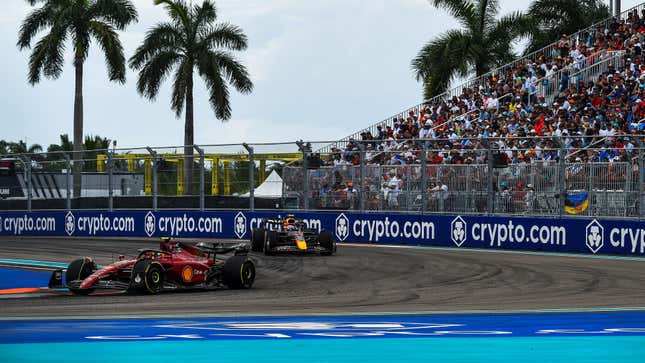
The on-again-off-again Formula 1 Miami Grand Prix finally had its first running earlier this month, and despite plenty of hiccups and concerns along the way, it was a success as far as event planning was concerned. I was lucky enough to attend, and I’m here to answer a few questions about what it as like, logistically, to fly to Miami and spend time at the track.
I do want to note that I attended as media, not as a fan, so my experience was totally different from that of the folks who bought tickets and braved the grandstands. I wandered through the track several times, but I also had the pleasure of hiding out in the air conditioned media center when I got too warm — and I also didn’t have to pay for tickets. Thankfully, my great friends at the Two Girls 1 Formula podcast are giving Jalopnik a breakdown of costs from the fan perspective.

Flights and Lodging
When an F1 race is in town, everything jumps in price — and that includes flights and lodging.
I initially purchased my own flights and lodging, but Red Bull later offered to host me as a guest, so I was able to have most of the previous expenses refunded. Red Bull paid for my flights and a South Beach hotel for Friday, Saturday, and Sunday nights. I had originally booked an Airbnb and was able to shorten my stay; I covered Wednesday and Thursday nights out of my own pocket.
I flew into Miami the Wednesday before the race and left the Monday after race weekend. When I booked things myself, I splurged a little to get direct flights via JetBlue, which totaled $609 with all the fees. As soon as I booked those flights, though, JetBlue cancelled a ton of routes, so I was redirected through New York City and given the option to cancel the trip for a full refund. When Red Bull offered to book my flights, they found a direct flight via American Airlines.
I also booked my own Airbnb in Hollywood for the full weekend (Wednesday through Monday), which totaled $749. I shortened my stay to merely Wednesday through Friday. The hotel that Red Bull booked in South Beach was roughly $750 per night.

Traffic and Parking
As you can imagine, the traffic situation was rough, but it wasn’t as bad as I expected. During the weekend, I was making the trip from Miami Gardens to my South Beach hotel, and it took anywhere from 40 to 60 minutes driving out from the track. On my way into the Hard Rock Stadium in the morning, I was generally able to make the drive in 30 minutes, with an extra 10 minutes for parking.
However, I was parking in the media lot, which was a long strip of dirt road that bordered the outside of the front straight. Standard fans were asked to walk up to a mile to the track from parking lots scattered around Miami Gardens. The immediate track vicinity was the most congested area I encountered traffic-wise, largely because there were so many people on foot. There was also a lot of nonsense on the highway thanks to police escorts for high-profile guests.

Facilities
For media and other high-profile guests, the Miami International Autodrome featured some gorgeous facilities, largely thanks to the fact that the media center and VIP suites were located inside the Hard Rock Stadium. The media center was bright and airy, which is a nice change from other media facilities (at the Circuit of the Americas, media just sits in a dark, windowless room). I also got a chance to watch the start of the race from the Red Bull VIP suite, which featured exterior viewing areas and an indoor, air-conditioned room.
Regular fans weren’t quite as lucky. Because the race largely took place in a parking lot, shaded rest areas were few and far between. There were some large covered areas where fans could sit to eat, and the Port-a-Potties were also blissfully covered — but grandstands, general admission viewing areas, walking paths, and many eating areas were totally exposed. There was also very little breeze inside the track, so it generally felt much warmer than it was.
That being said, it was obvious that Miami promoters were conscious of the fact that a lot of people were turning up to the race, so there were more fan areas at the track than I’ve seen at many other street circuits. A lack of shade is also fairly common at road courses — but the flat nature of the track exacerbated a lot of the unpleasant bits of humid Florida heat.
In terms of food options, I spotted everything from standard track fare (chicken strips and french fries, pizza) to local favorites like arepas. There was even a sushi stand for the godforsaken souls who decided they wanted to eat sushi from a food tent. Prices, though, were on par with or higher than other tracks; beer was going for $7 to $10, single-shot frozen margaritas were $18, and a slice of pizza was $9.
For a first-year, non-permanent track, I thought Miami promoters did a decent job. There are plenty of opportunities for growth, including better parking options and more shaded areas, but it was a great first effort and a very solid base for the track to learn from.